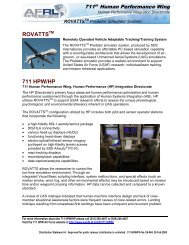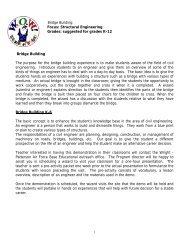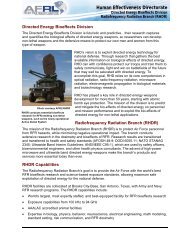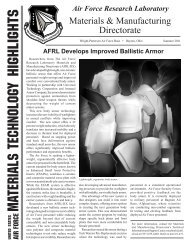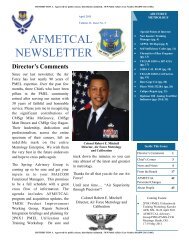Plant 44 Audit Reports - Wright-Patterson Air Force Base
Plant 44 Audit Reports - Wright-Patterson Air Force Base
Plant 44 Audit Reports - Wright-Patterson Air Force Base
- No tags were found...
Create successful ePaper yourself
Turn your PDF publications into a flip-book with our unique Google optimized e-Paper software.
3.1 The following observations were noted:3.1.1. KUDOS. Security was prompt in responding and setting up for traffic controlbefore the fire department's arrival. The use of the 'bike patrol' was beneficialallowing quick response to control pedestrian and vehicle traffic early in theevent. The locked gate (Gate C) on the access road adjacent to the building wasimmediately opened allowing fire approach from the quickest and appropriatedirection. The coordinated response by the security, maintenance and fire wascommendable.3.1.2. Mutual Aid. The Fire Officers were counting on several fire ground duties,operations and support to be performed by outside fire companies during the earlystages of the incident. Although mutual aid training is a requirement, trainingwithout their support should also be accomplished. (Action required)3.1.3. Radio communication and the switch to the emergency frequency were welldemonstrated.3.1.4. Hose Advancement: The appropriate fire hydrant was used the supply the firstEngine. Using the exterior stairs, a supply line was hauled up the stairs that waslater used to supply a smaller hose from a gated wye. In addition, a 'highrise/hospital pack' was also advanced to the roof for the initial attack making theinitial attack more manageable.3.1.5. Incident Management System: The communications between the incidentcommander from the operation commander (81 OIC) and rescue personnel wereweak. The IC was duel role as the Fire Officer lC and a Security Officer. TheFire Officer should have been the Incident Commander (8tOIC) and the CrewChief from the first Engine whose call sign was 81 OIC should have beenOperations-IC/Roof-lC. Putting the IC at the close proximity to the incidentforced supporting agents to report to the OpslC instead of the IC who has overallresponsibility. This removes the IC from having full control of the operations andplaces support people too close to the scene and possibly interfering with theoperations of the OpslC. Case-in-point, the Security representative that was faceto-facewith the OpsIC was exposed to on-scene dangers. The rescue and firesuppression operations on the roof were not monitored or directed by a fire officerin view ofthe operations. As a result, the fire suppression operation was beingperformed in an unsafe manner by one fire fighter on the end of the hose line ashis backup person separated himself from the operations. Recommendation:Establish requirements for an incident management system to be used byemergency services to manage all emergency incidents IA W NFPA 1561,Standard on Emergency Services Incident Management System. Also ensure thatthe Incident Management System is compatible with outside support agencies.(Action required)3.1.6. Immediate Danger to Life and Health (lDLH): It was unclear to the evaluators asthe where the IDLH area was established. This made it unclear as to where to setup the Accountability person and where fire fighters were required to be 'on-air'and where the Rapid Intervention Team (RIT) and Rehap area were to be formed.Recommendation: Conduct more exercises. Ensure all fire operations are lAWAttachment 5




